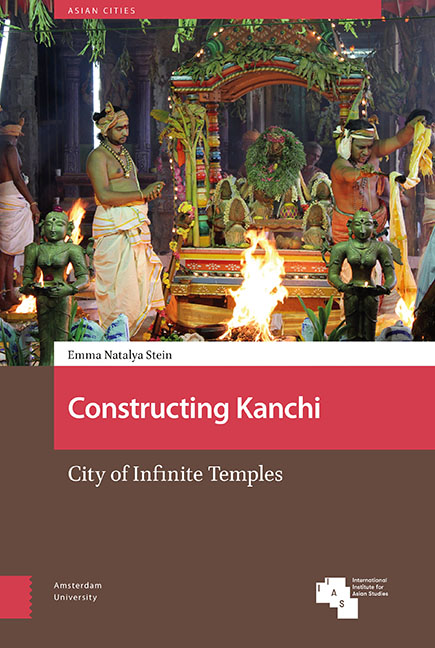Book contents
- Frontmatter
- Dedication
- Table of Contents
- Acknowledgments
- List of Illustrations
- Note on Transliteration, Translation, and Illustrations
- Introduction: All Streets Lead to Temples
- 1 Sandstone and the City: Building Pallava-Kanchi (ca. seventh through ninth century)
- 2 Realignment: Kanchi in the Chola Era (ca. tenth through thirteenth century)
- 3 The City and its Ports
- 4 Kanchi Under Colonialism
- Epilogue: The Living Temple
- Bibliography
- Index
4 - Kanchi Under Colonialism
Published online by Cambridge University Press: 16 December 2021
- Frontmatter
- Dedication
- Table of Contents
- Acknowledgments
- List of Illustrations
- Note on Transliteration, Translation, and Illustrations
- Introduction: All Streets Lead to Temples
- 1 Sandstone and the City: Building Pallava-Kanchi (ca. seventh through ninth century)
- 2 Realignment: Kanchi in the Chola Era (ca. tenth through thirteenth century)
- 3 The City and its Ports
- 4 Kanchi Under Colonialism
- Epilogue: The Living Temple
- Bibliography
- Index
Summary
Abstract
Using colonial-era sources, Chapter Four examines Kanchi at the crucial moment when Indian art and geography was first being systematized, interpreted, and transmitted by Europeans. A popular narrative was established that characterized Kanchi as a city in decline – yet this narrative is belied by Colonial-era prints, drawings, and travelers’ accounts. While photographs show Kanchi's Pallava temples in various states of ruination, these alternative sources tell a story of Kanchi as a flourishing urban center. The original sources include the collected manuscripts of Colin Mackenzie, the architectural writings of James Fergusson, the private diaries of Henrietta Clive (Robert Clive's daughter-in-law), and the drawings and letters of the Russian aristocrat Alexis Soltykoff, who described Kanchi as a city of ‘infinite temples.’
Keywords: Nineteenth century, Photography, Clive of India, Panorama, Mysore Wars, Pallava temple
On 11 March 1800, Lady Henrietta Antonia Clive and her entourage arrived in Kanchi. A portrait by Sir Joshua Reynolds, painted two decades earlier, shows her in stately elegance, donning a wide-brimmed, peacock-blue hat and swathed in a heavy dress the color of cream, with a slightly dissatisfied look across her face (Ill. 76). Armed with Robert Orme's recently published A History of the Military Transactions of the British Nation in Indostan as her guidebook, restless Henrietta struck out to see places associated with her father-in-law, Robert Clive – the famous ‘Clive of India’ – while her husband Edward remained stationed in Madras. According to the diary of Charlotte Clive, Henrietta's then twelve-year-old daughter, the party totaled 750 people, plus oxen, camels, and no less than fourteen elephants. Charlotte's description is worth quoting in full for the sense it gives of how they traveled and the impressions of India they held.
Fourteen elephants were employed to carry our tents, which consisted of two large round tents, six field officers, three captains, and several smaller tents for the cavalry, infantry, etc. by whom we were escorted. Four elephants were employed in carrying a part of our baggage; two were not loaded that had been trained for carrying howdahs, which we sometimes rode when the weather was not too oppressive.
- Type
- Chapter
- Information
- Constructing KanchiCity of Infinite Temples, pp. 199 - 266Publisher: Amsterdam University PressPrint publication year: 2021



